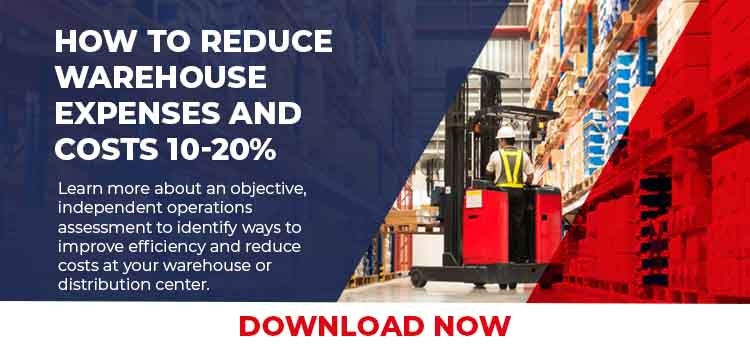Warehousing and distribution are dynamic industries, with many facets always in motion – whether it’s the changing supply chain to meet current constraints, continual shipping cost increases, or labor challenges that threaten to impede growth. The operations in your distribution center must also change, driven by a mindset of continual process improvement as part of your overall supply chain strategy.
All too often, we see operations that have become stagnant or once optimized but then managed and run the same way for many years with little change. Many times, they have not stayed proactive, and their costs, processes, and systems do not serve the company well.
Distribution and warehouse operational assessments allow companies to review the people, processes, layout, and systems to identify where, and how, changes should occur. The goal of any operations assessment is to improve operational efficiencies; drive down costs; increase throughput while meeting or exceeding customer expectations.
 In short, a warehouse assessment or warehouse evaluation, should be performed at least once per year. Some companies benefit from more frequent, smaller assessments based on key events such as changes in seasons or acquisitions.
In short, a warehouse assessment or warehouse evaluation, should be performed at least once per year. Some companies benefit from more frequent, smaller assessments based on key events such as changes in seasons or acquisitions.
At a minimum, your operations team should engage in a methodical operations assessment once per year. This assessment typically coincides with the end of the primary peak season or the end of the fiscal year. This provides the ability to take a step back and reset the operations and facility to support the coming year or season.
Other drivers that should trigger an operations assessment include:
Fail To Meet Customer Expectations
There is a substantial risk once the operations have missed meeting the customers’ expectations, resulting in lost sales. Unfortunately, this happens frequently. Here are some key questions to answer:
- Is order fulfillment not processing customer orders in a timely manner and in line with operations standards?
- Are there order picking accuracy or shipping issues that drive up customer service complaints and returns?
- Are inbound inventory receipts taking longer than expected, further impacting pre-existing backorders?
- Are you proactively slotting SKUs to improve fulfillment and warehouse efficiency?
Additional Product Lines
When new product lines are introduced, the operations must quickly identify how the new product will impact the operations beyond just increased storage.
- Will new SKUs require new storage methods or even certain conditions such as climate control? What would need to change in the operations to support these requirements?
- Will the changes to storage necessitate changes to the layout and design?
- Do the new items require different labeling or packaging that would require changes to processes, systems, packing stations, or shipping?
- Can the new SKUs be accommodated with the current conveyors and material handling? Or will additional changes in conveyors and automation be required, or more beneficial?
Decline In Current Storage Capacity And Utilization
A facility is at capacity long before it appears to be “full” because space is always needed to maneuver floor stacked pallets, putaways, and peak processing. This specific point tends to be one of the key areas that drive the need for an operations assessment for many companies.
- Have you maximized the existing stock locations and need to find opportunities for expanding storage?
- If the facility is “full”, do you need to find ways to extend the life of the facility for the remaining lease term?
- Are there opportunities for improving the utilization of the existing locations?
Acquisition Of New Business
At a macro level sometimes acquisitions of similar categories may look like they should not be a problem. Take for example hanging apparel versus flat apparel. You need to look at the product characteristics, storage, packing, and number of SKUs to evaluate the impact.
- Will the acquisition add a distribution center to the operations; or will product be moved and stored in an existing facility within your supply chain?
- Are the vendors the same and therefore not require more labor or change in the process? Or will new vendor compliance programs need to be implemented (e.g., EDI of orders, shipments, invoices).
- Will the center offer additional value-added services?
- How will the acquisition change the utilization of labor or the throughput and productivity rates?
- Will the existing warehouse management system (WMS) be utilized, or will you need to transition them to your current WMS?
Decline In Inventory Accuracy
When the inventory accuracy declines, workers begin to lose confidence in the system as well as processes, often leading to a larger erosion in the operations. Working exceptions like “warehouse backorders” slows operations and increases cost.
- Is the “four wall” inventory accurate, but the bin level accuracy is incorrect?
- Have workers developed their own workarounds to cope with the existing inventory challenges?
- Are you performing a methodical, disciplined cycle count routine and physical inventory process?
- Do you have an inventory audit trail of products and storage locations and storage locations and product? Can you identify what has led to, or caused, the inventory variances in the operations?
- Is the current inventory system adequate to support the needs of your company?
- Do you have a DC inventory staff that develops processes, does cycle counts, and looks to increase accuracy?
Escalating Fulfillment Costs
Fulfillment operations are seeing all aspects of their budgets increasing from labor, and packing supplies to shipping, all with a negative impact on profit margins.
- With increased labor costs, has the overall productivity and throughput remained the same, or even decreased over time?
- Are there changes in the operations that inadvertently impact the fulfillment costs in a negative way?
- How do you see your labor market changing and impacting fulfillment costs, productivity, and bottom line?
- Is there sufficient training to reduce new hires' training costs? What training would make exiting employees more productive?
In summary, to improve your operations, an assessment of your fulfillment processes will allow you to identify the challenges as well as opportunities, along with ways to take corrective actions. From here, you can then perform ongoing warehouse operations assessments as a way to proactively keep operations lean and make changes in the supply chain.
As part of our distribution consulting services, F. Curtis Barry & Company has conducted operations assessments for hundreds of companies, helping them become more efficient reducing costs; improving customer service; and dealing with changes in company operations and supply chain.







SHARE